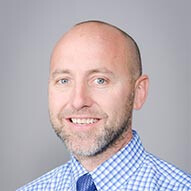Spinal problems in children
At the Children's Health℠ Andrews Institute, our highly skilled team of orthopedic specialists treats a wide variety of spinal problems in children. Our goal is to deliver your child the most personalized, comprehensive care possible.
What are spinal problems in children?
Spinal problems in children happen when the spine is abnormally curved, pressuring the vertebrae (small bones of the spine) and causing back pain and other problems.
What are the different types of spinal problems in children?
Scoliosis - An abnormal sideways curve of the spine, with the twists and rotation causing back pain and, in severe cases, problems breathing (learn more about scoliosis)
Spondylolysis - An overuse injury that causes tiny stress fracture in the vertebrae, most commonly in the lumbar spine in the low back
Spondylolisthesis - A condition that occurs when one of the vertebrae slips forward, causing back pain and muscle tightness
Kyphosis - An abnormal outward curve in the mid-spine, causing a “humpback” look
Lordosis - An abnormal inward curve in the low-spine, causing a “swayback” look in which your child’s buttocks stick out more than normal
At the Andrews Institute, our program is designed to provide a superior level of expertise, advanced technology and innovative care in one convenient location. We provide diagnosis, treatment and follow-up care such as physical therapy (PT) under one roof.
What are the signs and symptoms of spinal problems in children?
Signs and symptoms of spinal problems in children include:
Uneven shoulders
Uneven waist
One hip higher than the other
Tilted pelvis
Hunched back (kyphosis)
Shoulder blade that appears more prominent than the other
Difficulty breathing
At the Andrews Institute, we offer advanced diagnostic tools and pediatric orthopedic expertise to accurately diagnose your child’s unique symptoms.
How are spinal problems in children diagnosed?
At the Andrews Institute, our specialists have extensive experience diagnosing the full range of spinal problems in children. We work together to ensure your child receives an accurate and quick diagnosis.
Diagnostic tests may include:
Physical exam to look for abnormal curve in the spine and uneven shoulders, waist or hips
X-ray use invisible electromagnetic energy beams to take detailed images of the spine
CT (computed tomography) scan uses X-rays to make detailed images of your child’s spine
MRI (magnetic resonance imaging) scan uses magnetic fields and radio waves to take detailed pictures of the spine
Bone scans use a safe, small amount of radioactive substance to make detailed images of the spine
How are spinal problems in children treated?
Treatment for spinal problems in children depends on the severity of the abnormal curve. Most often, our physicians can use nonsurgical treatments for spinal deformities.
Nonsurgical treatments
Activity modification, particularly if the activity is causing continued injury to the spine
Bracing to hold your child’s spine in the proper position, correcting the abnormal curve
In-house physical therapy (PT) and rehabilitation to reduce muscular imbalance and increase strength and flexibility, improving posture
Surgery
Our goal is always the least invasive, most effective option. If symptoms worsen, though, your child may need surgery. If so, our surgeons use the latest tools and technology to realign and straighten your child’s spine.
Spinal problems in children doctors and providers
 Alvin Chi, MDSports Medicine Physician
Alvin Chi, MDSports Medicine Physician Christopher Redman, MDOrthopedic Sports Medicine Surgeon
Christopher Redman, MDOrthopedic Sports Medicine Surgeon Troy Smurawa, MDSports Medicine Physician
Troy Smurawa, MDSports Medicine Physician Brian Gutknecht, PA-CPhysician Assistant - Orthopedics
Brian Gutknecht, PA-CPhysician Assistant - Orthopedics